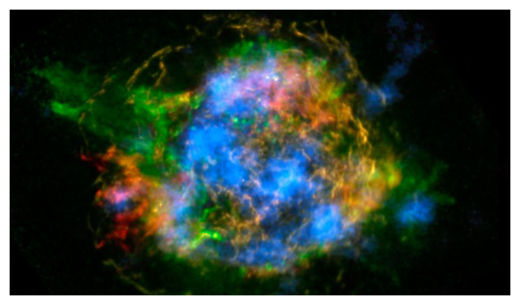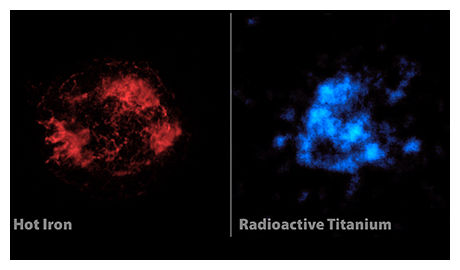
© NASA/JPL-Caltech/CXC/SAOCas A as seen by NuSTAR (blue) and Chandra (red, yellow and green).
Massive stars are thought to end their lives in cataclysmic explosions, leaving behind neutron stars or black holes as their corpses.
But there are even stranger possibilities.
Cassiopeia A exploded some 300 years ago and is now a beautiful cascade of gases surrounding a neutron star (or so we think). Dozens of ground- and space-based telescopes have collected the remnant's light over the years. And recently, NuSTAR - NASA's latest high-energy X-ray satellite - stared at Cas A for 13.8 days straight, shedding light deep into this remnant.
Now, astronomers from the University of Calgary in Alberta, Canada, have proposed a more exotic scenario: days after the first supernova explosion, the neutron star exploded once more, creating a quark star instead.
"It's hard not to imagine that nature wouldn't make use of this stage between a neutron star and a black hole," says lead author Rachid Ouyed, one of the first scientists to suggest the concept. "A quark nova can be thought as a bridge between these two."
Quarks are the fundamental building blocks of matter. They normally associate in groups of two or three, producing familiar protons and neutrons. But, like any new ideas in theoretical physics, they're enshrouded in controversy and debate.
Some physicists think that extremely dense matter settles into a soup of individual quarks, while others think it isn't possible for quarks to exist on their own. The energy required to separate quarks would create new quarks, which would immediately bind with any quarks being separated.
While no earthbound experiment has produced an individual quark, the remnants of extremely hot and massive stars present a great laboratory to test the theory and settle the debate.
When the core of a massive star runs out of energy, it collapses to form an incredibly dense neutron star or black hole. Bring a teaspoon of neutron star to Earth, and it would outweigh Mount Everest at about a billion tons. If a neutron star's density continued to increase - because it received additional mass or slowed its spin rate drastically - the core would collapse even further. That extra pressure could set quarks free from their original protons and neutrons.
At this stage, the only mechanism keeping these particles separated is a law that forbids them from occupying the same quantum states. Some quarks will be forced into much higher energy states, so high they actually convert to heavier quarks.
"Large amounts of energy can be liberated in a short time when this transformation happens," says quark nova expert Jan Staff (Macquarie University, Australia). "This energy will tear off the crust of the neutron star, creating ejecta consisting of the heavy elements of the crust in addition to many neutrons. This explosion is the quark nova."
But a quark nova remains theoretical. Though it would likely occur a few days after the supernova, the first explosion's expanding gases would hide the second detonation. So instead astronomers look for hints in the messy aftermath of gases: the resulting supernova remnant.
Elements form one after another within the star before it explodes, leading to onion-like shells within the supernova remnant. Two elements in particular, titanium and iron, form in nearly the same location less than a second before the star explodes.

© NASAChandra's hot iron map compared to NuSTAR's radiocative titanium map.
Yet by comparing NuSTAR's titanium map with Chandra's previous map of heated iron, it's clear that in Cas A the two elements are found nowhere near each other. In addition, it appears that there is more titanium than expected and too little iron.
Ouyed and colleagues think the high-energy neutrons from the quark nova would destroy the iron and form lighter elements, one of which is titanium. The quark nova is crucial in this picture, as it provides the neutrons necessary to form the lighter element, says Staff.
There's one caveat: since Chandra only sees iron atoms shocked to temperatures high enough to emit X-rays, it's possible there's cooler iron hiding within the remnant.
Even so, the fact that titanium and iron don't align is troubling.
Brian Grefenstette (California Institute of Technology) and colleagues took a detailed look at these results earlier this year. They argued that titanium's uneven distribution results from
sloshing within the star itself just before its demise.
"But this doesn't help explain why the iron and titanium spatial maps are so different," says Grefenstette. In the quark nova explanation, Ouyed and colleagues "really try to explain much of the morphology that we see in Cas A ... and make several predictions that may be testable over the next couple of years."
While the quark nova theory will need to be confirmed, Staff thinks these initial results are highly important.
"I feel we have found the door - the quark nova - to enter the quark world like never before," says Ouyed. "It's going to be a very exciting time for astrophysics if we can confirm a quark nova in Cas A."
Reference:R. Ouyed
et al. "Evidence for a Second Explosion (a Quark Nova) in Cassiopeia A Supernova,"
Imagine the fact there is no fusion in the star core, no iron core, its all imagination of scientists... Making these theories super wrong.